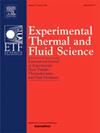质子交换膜电解过程中电极表面变形对氢泡动力学的影响
IF 3.3
2区 工程技术
Q2 ENGINEERING, MECHANICAL
Experimental Thermal and Fluid Science
Pub Date : 2025-06-23
DOI:10.1016/j.expthermflusci.2025.111538
引用次数: 0
摘要
水电解系统对长期太空探索任务中维持人类生命至关重要。水电解系统在太空中运行的主要障碍是浮力几乎没有,这阻碍了氢气和氧气气泡从电极上分离出来,并进一步复杂化了气体管理,这是即使在地面应用中也能高效运行的关键因素。减轻这个问题的最有希望的方法之一是电极表面的微或纳米结构。通过表面结构,可以扩大电化学活性表面积,提高亲水性,使气泡更容易脱离。此外,可以改善气泡成核,减少气泡合并。本研究制作了五对激光织构电极,对其性能及其对产生氢气气泡动力学的影响进行了表征和分析。与未经修饰的表面相比,所有纹理电极的性能都得到了提高(在相同的电源电压下,电流密度提高了10%至45%)。产气实验证明,在给定电压下,电流密度的增加直接对应于生产率的提高,从而提高了电解性能。在不同的表面以及不同的电源电压下,观察到气泡尺寸分布的显著差异。分布形状和参数(均值和标准差)随着时间的推移基本保持不变。气泡上升速度受上升气泡羽流夹带的影响显著。分离后的气泡生长受扩散控制,主要由靠近电极的过饱和程度决定。该研究证明,电极表面形貌的改变通过改变操作过程中的气泡行为来影响PEM系统的性能。本文章由计算机程序翻译,如有差异,请以英文原文为准。
Impact of electrode surface texturing on hydrogen bubble dynamics during proton exchange membrane water electrolysis
Water electrolysis systems are vital for sustaining human life during long-term space exploration missions. The main obstacle to the in-space operation of a water electrolysis system is the near-absence of buoyancy forces, impeding the detachment of hydrogen and oxygen bubbles from the electrodes and further complicating gas management, a crucial factor for efficient operation even in terrestrial applications. One of the most promising approaches to mitigate this problem is the micro- or nanostructuring of the electrode surfaces. Via surface structuring, the electrochemically active surface area can be enlarged and hydrophilicity increased, leading to easier detachment of gas bubbles. Additionally, bubble nucleation can be improved and bubble coalescence reduced. In this study, five pairs of laser-textured electrodes are manufactured, characterized and analyzed in terms of their performance and their influence on the bubble dynamics of the produced hydrogen gas. All textured electrodes achieve a performance enhancement over the unmodified surface (10% to 45% increase in current density for the same supply voltage). Gas production experiments prove that an increase in current density at a given voltage directly corresponds to a rise in production rate and, hence, in electrolysis performance. Significant differences in the bubble size distribution are observed on the different surfaces, as well as at different supply voltages. Distribution shapes and parameters (mean and standard deviation) remain mostly constant over time. Bubble rise velocities are significantly influenced by the entrainment of flow by the rising bubble plumes. Bubble growth after detachment is proven to be diffusion-controlled, and mainly determined by the degree of supersaturation close to the electrodes. This study proves that modification of the electrode surface morphology influences the performance of PEM systems by alteration of the bubble behavior during operation.
求助全文
通过发布文献求助,成功后即可免费获取论文全文。
去求助
来源期刊

Experimental Thermal and Fluid Science
工程技术-工程:机械
CiteScore
6.70
自引率
3.10%
发文量
159
审稿时长
34 days
期刊介绍:
Experimental Thermal and Fluid Science provides a forum for research emphasizing experimental work that enhances fundamental understanding of heat transfer, thermodynamics, and fluid mechanics. In addition to the principal areas of research, the journal covers research results in related fields, including combined heat and mass transfer, flows with phase transition, micro- and nano-scale systems, multiphase flow, combustion, radiative transfer, porous media, cryogenics, turbulence, and novel experimental techniques.
 求助内容:
求助内容: 应助结果提醒方式:
应助结果提醒方式:


